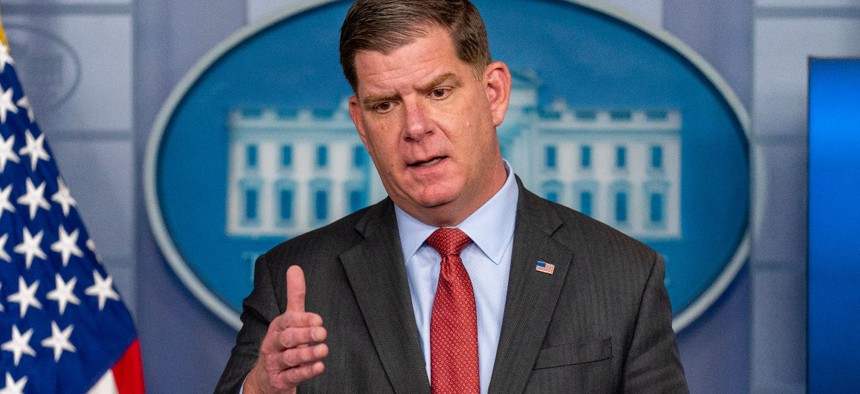
Labor Secretary Marty Walsh is leading a task force with Vice President Kamala Harris to identify policy changes to promote worker empowerment. Andrew Harnik / AP
Biden Signs Executive Order to Promote Collective Bargaining
A new task force made up of federal agency heads is charged with identifying ways to encourage “worker empowerment,” including acting as a model employer that fosters unions at agencies.
President Biden on Monday signed an executive order aimed at identifying new and existing policies across the federal government to encourage workers in both the public and private sector to organize and form labor unions and reaffirming that agencies should act as a “role model” for employers.
The Executive Order on Worker Organizing and Empowerment establishes a task force, which will be led by Vice President Kamala Harris and Labor Secretary Marty Walsh and made up of more than 20 federal agency heads, and tasks the group with identifying existing policies that can be leveraged to encourage labor organizing, particularly in states with “hostile” right to work laws and in industries that are considered “hard to organize.” It also instructs the agency heads to recommend a series of policy changes that can be made via regulations or legislation to make it easier to organize workplaces.
Biden wrote that the task force marks the start of an effort to, for the first time, fully implement the policy provisions of the 1935 National Labor Relations Act.
“The National Labor Relations Act proclaims that the policy of the United States is to encourage worker organizing and collective bargaining and to promote equality of bargaining power between employers and employees,” the order states. “In the past few decades, the federal government has not used its full authority to promote and implement this policy of support for workers organizing unions and bargaining collectively with their employers. During this period, economic change in the United States and globally, technological developments, and the failure to modernize federal organizing and labor-management relations laws to respond appropriately to the reality found in American workplaces, have made worker organizing exceedingly difficult.”
In a fact sheet accompanying the order, the White House said the task force’s goals are four-fold. First among those is for federal agencies to “lead by example,” encouraging efforts by federal employees to organize and negotiate with agency management.
The task force would also seek to find new ways for workers to organize in states with “restrictive labor laws,” as well as with an eye to the additional challenges that women and workers of color face in collective bargaining, and to increase union membership more broadly across the country. The group’s first set of recommendations are due in 180 days.
Paul Shearon, president of the International Federation of Professional and Technical Engineers, which represents workers in the federal government, state agencies and the private sector, endorsed the establishment of the task force.
“IFPTE applauds President Biden for once again walking the walk by using his bully pulpit to promote and move policies that are geared toward increasing union membership here in the United States,” Shearon said. “This latest news of the creation of a White House task force dedicated toward empowering working Americans seeking to organize unions and collectively bargain will ensure that this will continue to be a front and center issue for years to come.”
American Federation of Government Employees National President Everett Kelley said the executive order will both improve the lives of federal employees and ensure more workers in the private sector can become part of the middle class.
“With today’s action, [Biden] is continuing to deliver on his campaign promise to be the most pro-union, pro-worker president ever,” Kelley said. “[Making] it easier for workers to join a union will help more Americans share in the better wages, benefits and working conditions that come with union membership—growing our economy from the bottom up and the middle out.”







